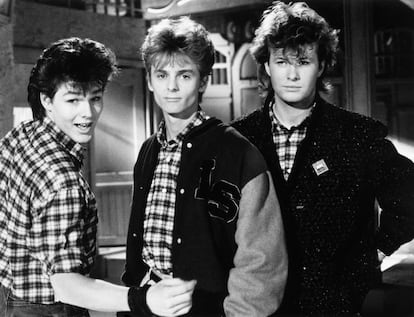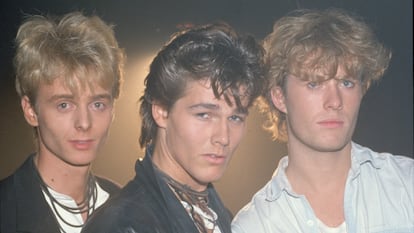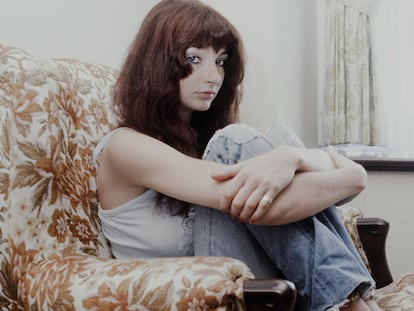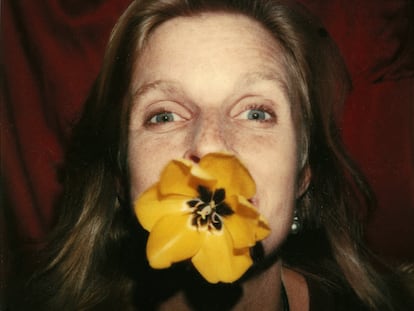A-ha: How three guys who can’t stand each other survived the biggest pop song of the ‘80s
The documentary ‘Aha: The movie’ explores the strange world of the Norwegian trio who in 1985 released ‘Take on me,’ one of the most popular songs on Spotify almost 40 years later

How do you survive the premature success of an exceptional song? Not well, judging by what is stated in A-ha: The Movie, the 2021 documentary about the Norwegian pop band. If there’s one thing the group members have in common - aside from a less-than-laughable tendency to insult each other - it’s that all three of them hate Take on me.
For the band’s lead singer, Morten Harket, it’s become an ordeal to be asked to play Take on me night after night. The group is forced to repeat it over and over again, but they feel that it’s “not necessarily among the best songs.” It’s just one of many memories from a far-off era that isn’t coming back.
The guitarist, Paul Waaktaar-Savoy - much more resigned than his bandmates - understands that the song “is part of the sentimental memory of several generations,” and therefore no longer belongs to its authors. “It doesn’t even matter what we may feel about Take on me… it’s a tribute to our fans. They stood by us, and one of the few things they ask in return is that we play that particular song.”
The Golden Age of Pop overshadowed by a supernova
As for Magne Furuholmen, the group’s keyboard player - and rumored to be the leader behind the scenes - has a compelling reason to loathe his signature song: “[It’s] a light so bright that [it] obscures the rest of our songs.” Furuholmen talks about tracks that only the band’s most stalwart fans will remember at this point, such as Stay on These Roads, The Sun Always Shines on TV, The Blood that Moves the Body, and Cast in Steel. Magne describes them, with relaxed immodesty, as “symphonic pop masterpieces.” He is pained to see them overshadowed by their younger sister, a song that is “peculiar, kind of brilliant in its own way,” but one that casts too much light.
Furuholmen recalls that A-ha has a solid track record, with 10 studio albums, and that business greats like Kanye West, Radiohead, Noel Gallagher, Chris Martin and even Leonard Cohen have paid them respect. Clearly, the band is not a one-hit wonder, yet the shadow cast by its most famous song is so long that it’s impossible to ignore.
Take on me was released in the UK in October of 1984. The first version (you can listen here) went unnoticed, but the group, aware of its potential, commissioned a remix from Alan Tarney, producer to legendary singer Cliff Richard. The new version appeared on A-ha’s debut album, Hunting High and Low, and was released as a single in September of 1985, accompanied with a video made by Anglo-Irish filmmaker Steve Barron.
If the keyboard riff that served as the basis for the song was unforgettable from the first listen, what about Barron’s video? This masterpiece of rotoscoping - an animation technique involving the frame-by-frame tracing of the images of a real film with a machine, now in disuse, called a rotoscope - told a very simple story. A woman, played by British model and actress Bunty Bailey, was attracted to the scribbled version of Morten Harket, the protagonist of a vintage aesthetic comic book. Harket, in one of the most iconic images of the early 1980s, invited her into his world by holding out his hand from the depths of an illustration. After just a few seconds of romantic connection, a waitress crumpled up the comic in which the pair of lovers had found refuge… the black-and-white universe began to crumble. In the end, in a finale inspired by Ken Russell’s 1980 film Altered States, Bailey and Harket managed to escape from their crumpled paper prison and continue their love story as flesh-and-blood beings.

The three-minute-long fantasy was filmed in a cafe and soundstage in South West London. Barron’s team spent four months transforming more than 3,000 live-action frames into a minimalist alternate universe. Even today, it is still a delight to watch.
In the fall of 1985, the then-almighty MTV bet big on the music video. For the first time since The Wild Boys by Duran Duran, a video clip produced in the UK could compete with Michael Jackson’s Thriller or Billie Jean. Against the lavish opulence of those big-budget productions, Take on me triumphed thanks to a simple idea executed with precision and good taste, using a combination of neat visual effects and fine craftsmanship.
Beyond the music video
If you ask Barron, he’ll tell you that it was the video that made the song… and, for that matter, the band’s budding career. There are solid reasons that would support this thesis. For instance, 37 years later, Take on me is one of the most viewed video clips in history. On YouTube alone, it already exceeds 1.3 billion views, consolidating it as one of the four most-played songs of the 20th century, along with Nirvana’s Smells like Teen Spirit, Queen’s Bohemian Rhapsody and Sweet Child o’ Mine by Guns N’ Roses.
Furthermore, the song went to number one on the US singles charts, coinciding with the premiere of the video. In the medium-term, it would reach the top of the charts in 36 countries, including all of Western Europe… with the exceptions of Spain, France and, curiously, the United Kingdom, the place of residence of the singers, where it peaked at number two. Only The power of love, by Jennifer Rush, surpassed it.

It’s hard to imagine that Hunting high and low, the debut album of a trio of unknown Norwegians, could have sold tens of millions of copies without MTV. However, as cultural journalist Jenny Valentish notes, “it wouldn’t be fair to give all the credit to Barron’s video.” The song had its own virtues, starting with the “magical” keyboard line that speaks of “youth, innocence and zest for life.” There are just a couple of notes, but in them is “the essence of everything that the band had that was peculiar and genuine.”
Furuholmen and Waaktaar-Savoy already had that riff in their repertoire in the late 1970s, when they started playing together in a school band named Bridges. Schoolmates in Oslo, they were playing Doors covers and had already concocted a little instrumental piece, The juicy fruit song, which included that brilliant keyboard intro. Furuholmen explains that Bridges was a band that “dreamed about making it big and had all sorts of wacky guys pass through it, but when push came to shove, it always ended up being me and Paul playing in a garage, with a couple of half-baked songs, a guitar, a bass and no singer.”
The man with Dulux paint in his hair
They tried to fill this missing role as early as 1981, according to Furuholmen, by making an “unrefusable” offer (”come with us and you’ll be the leader of our band”) to the coolest guy they knew, another Norwegian named Morten Harket, who, like them, frequented London hoping to break into the music industry: “He had a great voice, but that was the least of it. “What fascinated us was that white-tinted quiff with Dulux paint and its connection to London’s New Romantic movement.” Harket was allowed into exclusive venues, such as Camden Palace. He was part of the scene, even if he was just a beardless Scandinavian with white paint in his hair. He already had a certain status, so he initially turned down the offer to lead a band with a horrible name, no manager and no set list.
A year later, when, back in Oslo, Furuholmen and Waaktaar-Savoy contacted Harket again, they had a few more songs and had changed their name. Since A-ha sounded much better than Bridges, the singer finally agreed to rehearse with them. Together, they turned The juicy fruit song into a piece with lyrics… very close to what would end up becoming Take on me.
Furuholmen explains that, like good Vikings, they crossed the North Atlantic again in the direction of Great Britain. This time, they were determined to succeed in the scene of extravagance and glamor that they had previously attended as simple spectators. “We made a decision to take things as far as we could commercially and go from being a garage band to pop stardom.”
Opportunity presents itself
The London they found in 1983 was no longer the London of 1981. The leading clubs were moving away from the New Romantic orthodoxy once it had broken into the mainstream, thanks to bands like Spandau Ballet and Duran Duran. A new breed of technopop bands were taking over, reclaiming some of the sass and avant-garde energy of punk.
A-ha fit like a glove in this latest mutation of the new wave. They enlisted the services of an old-school manager, Terry Slater, once a bassist for the Everly Brothers. Slater got them a contract with Warner and, above all, he acted as a tireless guard dog. According to Furuholmen, “[Slater] preserved our innocence, kept us safe from drugs and bad company.”
Years later, they discovered that the savvy manager had banned A-ha’s social and professional circle from taking drugs in their presence. “He had worked with drug-fueled bands like the Sex Pistols and wanted us to stay clean, healthy and focused, to the point that he would threaten to break people’s legs if they took drugs around [us].”
Slater’s influence and the group’s own inclinations explain A-ha’s considerable longevity. They are still together and active almost 40 years after their second landing in London, despite the fact that coexistence within the group began to deteriorate by the end of the 1980s. The band has been dissolved at least three times… but they always get back together.
Just as we were
Today, as the documentary dedicated to A-ha’s long journey shows, very little remains of the friendship that thrived during the group’s early years. In Harket’s words, they are “three skilled professionals condemned to understand each other.” Theirs must already be one of the longest marriages of convenience in pop history. A band built up as a vehicle to reach success as quickly as possible has survived against all odds thanks to the obstinacy of its members, who, as Waaktaar-Savoy explains, travel separately, meet in the studio or on stage and barely talk about anything except what has to do with the band. They know each other well and, to some extent, respect each other. But they can barely stand each other.
That’s one of the most curious questions that A-ha: The Movie raises. To what extent is it logical and healthy for three adults with more-than-healthy checking accounts to insist on keeping a common creative vehicle afloat, for which they seem to feel so little attachment?
The answer, as Furuholmen hinted in an interview with the Financial Times, is that they have found that it is very cold outside A-ha. Fame is addictive; no alternative project has anywhere near the same level of exposure that the band guarantees. And Take on me, together with the dozens of songs that came later, is a legacy to defend and a heritage—financial and sentimental—to preserve.
Furuholmen summarizes the main thing he has learned from life on the road in a handful of sentences in which common sense and the starkest cynicism naturally coexist: “There’s a rock-star handbook that everyone has to follow. It starts with buying Japanese cameras when you’re on your first successful tour and everyone thinks they’re a photographer. If you keep on getting successful you buy flats all over the world. Then you get interested in antiques, because you have to fill the flats up. Then you move on to vintage cars. Eventually, you end up buying a lot of art.”
None of this would have been possible without Take on me. Without the magical riff and the unforgettable video clip, there would be no art to collect, no tours to present Hunting high and low live on its 35th anniversary, and no documentary in which the three members of A-ha exhibit—with some cheek—how badly they get along.
The toll to pay for all of this is sharing the stage with a couple of guys you’d love to lose sight of, in front of people who ask you to play a song you hate night after night. It may not be the most uplifting of stories, but it is the one that the Norwegian band wanted to tell us.
Tu suscripción se está usando en otro dispositivo
¿Quieres añadir otro usuario a tu suscripción?
Si continúas leyendo en este dispositivo, no se podrá leer en el otro.
FlechaTu suscripción se está usando en otro dispositivo y solo puedes acceder a EL PAÍS desde un dispositivo a la vez.
Si quieres compartir tu cuenta, cambia tu suscripción a la modalidad Premium, así podrás añadir otro usuario. Cada uno accederá con su propia cuenta de email, lo que os permitirá personalizar vuestra experiencia en EL PAÍS.
¿Tienes una suscripción de empresa? Accede aquí para contratar más cuentas.
En el caso de no saber quién está usando tu cuenta, te recomendamos cambiar tu contraseña aquí.
Si decides continuar compartiendo tu cuenta, este mensaje se mostrará en tu dispositivo y en el de la otra persona que está usando tu cuenta de forma indefinida, afectando a tu experiencia de lectura. Puedes consultar aquí los términos y condiciones de la suscripción digital.
More information
Últimas noticias
Most viewed
- Sinaloa Cartel war is taking its toll on Los Chapitos
- Oona Chaplin: ‘I told James Cameron that I was living in a treehouse and starting a permaculture project with a friend’
- Reinhard Genzel, Nobel laureate in physics: ‘One-minute videos will never give you the truth’
- Why the price of coffee has skyrocketed: from Brazilian plantations to specialty coffee houses
- Silver prices are going crazy: This is what’s fueling the rally











































